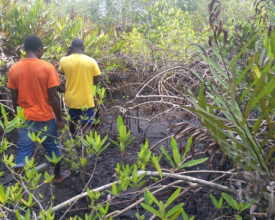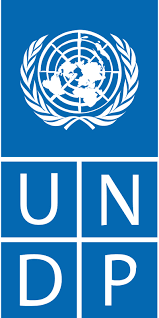
Regeneration of Mangroves and Mobilization of Local Populations, with a Particular Focus on Women and Indigenous Communities, in the Conservation of Ecosystems in the Lokoundjé District (Fifinda)

The Foundation for Environment and Development in Cameroon (FEDEC) implemented a project titled ‘Mangrove Regeneration and Mobilization of Local Communities, Particularly Women and Indigenous Groups, in Ecosystem Conservation in the Lokoundjé District (Fifinda),’ funded by GEF Small Grant from the United Nations Development Program. This initiative aimed to restore 4 hectares of degraded mangrove areas through the replanting of 6,000 mangrove seedlings and fostered community engagement, particularly among the Bakola/Bagyeli indigenous communities, in agroforestry activities. The project also introduced improved fish smoking ovens, reducing deforestation and enhancing local economies. Community education efforts, including the distribution of educational materials and radio broadcasts, raised awareness of mangrove conservation. The combined efforts have not only regenerated vital ecosystems but also empowered local populations with sustainable livelihoods and conservation techniques.
Context
Challenges addressed
The project addressed environmental, social, and economic challenges in Lokoundjé. It tackled mangrove degradation caused by deforestation and excessive wood use for fish smoking by reforesting 4 hectares with 6,000 seedlings and introducing improved ovens that reduced wood consumption and tripled fish production, linking conservation with livelihoods.
Socially, the project empowered local and indigenous Bakola/Bagyeli communities, particularly women, through awareness campaigns, educational materials, and radio programs on mangrove conservation. Women benefited from using improved ovens, enhancing their economic standing and role in environmental management. Additionally, 2 hectares of agroforestry plantations provided the Bakola/Bagyeli with food security and income opportunities.
Economically, the project increased local income through boosted fish production and diversified livelihoods via agroforestry, promoting sustainable resource use and long-term economic growth.
Location
Process
Summary of the process
The key success factors of the project are interconnected in a way that each element reinforces and complements the others to achieve positive results. Community outreach through various tools such as brochures, radio broadcasts and posters increases awareness and local ownership, ensuring that conservation efforts are adopted by the population. This leads to greater community involvement in activities such as reforestation and agroforestry, where local participation ensures the sustainability of interventions. The introduction of improved stoves contributes to this by reducing the need for wood cutting, directly contributing to the preservation of mangroves. In addition, the establishment of agroforestry systems provides alternative livelihoods, enhancing the economic benefits of conservation efforts.
Building Blocks
Community awareness campaigns
It aims to raise awareness among local and indigenous communities of the importance of conserving mangroves and adopting sustainable practices. The campaign uses a range of tools, including brochures, posters, loincloths and radio broadcasts, to reach various segments of the population. Awareness-raising activities aim to educate communities about the environmental and economic benefits of mangrove conservation, while promoting the adoption of improved stoves to reduce deforestation. The aim is to create a strong sense of local ownership, ensuring long-term commitment to conservation efforts.
Enabling factors
- Cultural relevance: The communication tools, such as pagnes, are adapted to local customs, increasing acceptance.
- Media access: Radio broadcasts ensure that information reaches remote areas.
- Local leadership support: Engagement of administrative and local leaders amplifies the campaign’s impact.
Lesson learned
- Effective communication:Adapting communication to the local context strengthens community involvement.
- Consistency: Ongoing dissemination and distribution of materials are essential to reinforce the message.
- Challenges: Ensuring that all community members, including marginalized groups, are reached can be difficult, and multiple platforms should be used to broaden outreach.
Mangrove reforestation and restoration
This building block involves the reforestation of degraded mangrove areas in Lokoundjé. Through the planting of 6000 mangrove seedlings across 4 hectares, the initiative aims to restore essential ecosystem services provided by mangroves, such as carbon sequestration, flood protection, and fisheries support. Local communities, particularly indigenous groups like the Bakola/Bagyeli, are actively involved in the planting and monitoring of mangrove health, reinforcing both ecological and social sustainability.
Enabling factors
- Community involvement: The involvement of local communities, particularly those directly affected, is essential to ensure the continuity of maintenance.
- Availability of seedlings: Access to healthy mangrove seedlings and training in appropriate planting techniques are necessary for successful reforestation.
- Government support: Legal support to protect reforested areas from exploitation also ensures the sustainability of restoration efforts.
Lesson learned
- Commitment is essential: Giving communities the means to replace damaged seedlings fosters a sense of ownership.
- Resilience in reforestation: Regular monitoring and replacement of seedlings, particularly in difficult environments, is essential to the success of the project.
- It is important to plan post-planting maintenance and to involve stakeholders early in the process to help avoid neglect of newly reforested areas.
Introduction of improved stoves
The introduction of improved stoves in Lokoundjé addresses both environmental and economic challenges. These stoves, measuring 5 meters by 1.3 meters, significantly reduce the need for wood by increasing fuel efficiency, which directly contributes to the conservation of mangroves. By tripling the production of smoked fish, the stoves also boost local economies. The stoves were designed and built with community participation, ensuring that they meet local needs while reducing pressure on natural resources.
Enabling factors
- Community involvement: Full participation of the community in the design and construction process ensures that the stoves are culturally appropriate and fit for purpose.
- Technical support: Access to experts for the design and maintenance of the stoves ensures their long-term functionality.
- Economic incentives: The ability to increase fish production and income encourages widespread adoption.
Lesson learned
- Community buy-in: Involving users in the design process improves adoption and long-term use.
- Sustainability: Without proper training, the stoves may not be maintained, leading to reduced effectiveness over time.
- Ensure that ongoing technical support and follow-up training are provided to maintain stove efficiency and functionality in the long term.
Agroforestry systems for indigenous communities
This building block focuses on the establishment of agroforestry systems in the villages of Ebéa and Maloumba, benefiting indigenous Bakola/Bagyeli communities. The system integrates cacao, plantain, and non-timber forest products (NTFPs) to provide diversified livelihoods and improve food security. Agroforestry helps reduce deforestation by promoting sustainable land use while enhancing soil fertility and increasing resilience to climate change. This initiative not only generates income for indigenous communities but also preserves their cultural heritage by combining traditional knowledge with modern agricultural practices.
Enabling factors
- Land ownership: Securing land rights for indigenous communities is crucial for the success of agroforestry.
- Training and capacity building: Providing education on sustainable farming practices and crop management is essential for long-term success.
- Access to markets: Ensuring that communities have access to markets to sell their products motivates participation and economic growth.
Lesson learned
- Inclusive planning: Engaging all members of the community, including women and youth, strengthens the project’s impact.
- Diversification: Integrating various crops and NTFPs reduces economic risks and enhances food security.
- Ensure that initial training is comprehensive and includes post-implementation support, as communities may face challenges in maintaining agroforestry systems without proper guidance.
Impacts
- Environmental Impacts: The project has restored 4 hectares of degraded mangroves in Lokoundjé by planting 6,000 seedlings. This effort enhances carbon sequestration, absorbing an estimated 1.2 tons of CO2 per hectare annually, helping mitigate climate change. Reestablished mangroves act as natural flood barriers, protect against erosion, and support critical habitats for fish and wildlife, promoting biodiversity. Regular monitoring and the replacement of 500 damaged plants have further bolstered ecosystem resilience.
- Social Impacts: The project empowered local communities, especially women and indigenous Bakola/Bagyeli groups, by involving them in conservation activities like mangrove planting and agroforestry. Over 40 community members participated, improving food security and livelihoods. Improved stoves reduced the time women spend gathering firewood, improving health and promoting gender equality by reducing indoor air pollution.
- Economic Impacts: The installation of three improved fish-smoking stoves in Lokoundjé tripled fish production capacity, boosting income by 30% for 50 households involved in fish smoking. The introduction of agroforestry systems in Ebéa and Maloumba, combining cacao, plantain, and non-timber products, has diversified income streams, enhancing economic resilience to climate risks.
Beneficiaries
The primary beneficiaries are the local communities of Lokoundjé, especially the indigenous Bakola/Bagyeli in Ebéa and Maloumba, with women gaining the most. The entire Lokoundjé population, including Kribi, benefited, along with local authorities.

